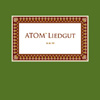Is Raster-Noton loosening up? 2007 foreshadowed their potential foray into techno with Signal’s Robotron and Frank Bretschneider’s Rhythm. The dream was realized last year with Byetone’s Death of a Typographer and “Plastic Star” 12″, in addition to the Gas book/CD. These motley releases are something of a face lift for a label heralded for its austere approach to sound and electronics. To have thought Uwe Schmidt would be a part of the no tone brand seemed far-fetched, given how his boisterous excursions into electronic Latin music wore on the patience of many, and the most exciting Schmidt release this decade may not have been anything on Rather Interesting, but the Nuclear Jazz reissue on Nonplace. Despite the lull, Schmidt is undeniably prolific, and his debut for Raster-Noton reminds us of his many talents.
Atomâ„¢’s Liedgut is the comeback release marking Schmidt’s escape from the doldrums. The album consists of five pieces, chopped into 20 tracks. It’s a gorgeously popped out/droned out affair, but unlike a Fennesz record, which can get bogged down in digital dust and non-committal meanderings, Liedgut has the guts to not just flirt with genre tropes, but confidently invoke their pathos to enable a progression from bossa nova to clicks & cuts and classical to Kraftwerk (Florian Schneider happens to make an appearance on this record). This is what Uwe Schmidt is legendary for, ingeniously marrying (and/or disastrously juxtaposing) the traditional with the electronic.
As always, Schmidt’s extreme attention-to-detail is evident in how he processes vocoder vocals on “Wellen und Felder II,” playing each verse off the last over time-lapsed drones akin to Stephan Mathieu and Ekkehard Ehlers’ Heroin. This game in sonic texture is important to AtomTM in constructing song structures, and serves as the materials with which he composes the form of Liedgut. As the Raster-Noton site explains, it is “an analogue expression of the romantic dualism,” defined scientifically on the one hand, but seeking philosophic/poetic ideas on the other. Above all, it’s an accessible album. Last weekend, I played it for my girlfriend’s dad, and he remarked, “It’s amazing… music and machines.” These are unlikely praises from an avid collector of Stax vaults and jump blues, and it spoke to how the furthest audience for Raster-Noton can connect with precise, abstract electronic music so long as it isn’t afraid to breathe human air.
Liedgut‘s headiest moments sound like a hybrid of Flanger and Alva Noto’s Trans-series: syncopated, slick, and flecked with the right amount of effects. While it’s nothing groundbreaking for Schmidt considering what he’s churned out as DOS Tracks, the grooves on Liedgut are tighter and more detailed than his previous funk reductions. Think of a high quality micro-house breakdown, something from your favorite Perlon record, then pretend the DJ decides to screwface you and rewind the track rather than let the beat drop. That feeling of calculated restraint, where the producer works meticulously to put you in a certain headspace only to yank you right out of it, is what Atomâ„¢ exercises on “Interferenz I” and “Im Rauschen der Gegenwart I.” If dance escapism were your goal Schmidt could be your guide, but on Liedgut he’s hardly concerned with where he could take the beat, and relies more on the inherent potential of beat-based music as one of many devices to layer, meld, and juxtapose the conventions of different music.
Liedgut essentially flips our perception of Raster-Noton on its head. Heretofore, R-N practically opposed invoking pathos. It was always more concerned with the logical, and the records, while usually fascinating, had a spectral quality to them, inhibiting “humanness” for the sake of process and concept. Liedgut is a clinically-produced record, but never before has the label released an album communicating the personality and identity of an individual producer so convincingly. For this reason, Liedgut is a truly refreshing project for both producer and label.
















“It’s amazing… music and machines.†I couldn’t agree more. This music sounds like it comes from Neuronmancer’s Wintermute, who, after processing Philip K. Dick’s “I Hope I Shall Arrive Soon,” sings lullabies as it cradles my (analog) brain: sweet & strange, weird & wonderful, holding on to hope. I’m left grasping for esoteric references beyond the music, and I can only find untenable literary references. I guess that’s why I find Liedgut masterful.
I absolutely adore the packaging on this CD, as well.
Very well done.
snd came out with their comeback album last week. noton bringing everyone out of the woodwork!
Hey, what’s my artwork doing at the top of this article?